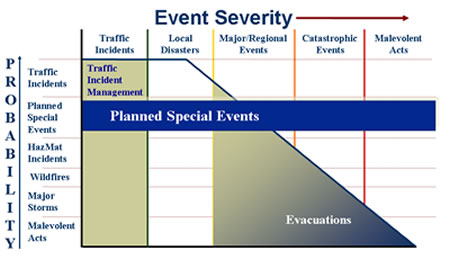

|
||
|
|
Emergency Transportation Operations for Disasters The table shows both the likelihood and the severity of the event. No matter the size or the probability of the event, to FHWA, the intent of Emergency Transportation Operations it to preserve/improve transportation network efficiency and public/responder safety when a non-recurring event either interrupts (traffic incident) or could overwhelm (PSE/evacuations) the transportation system. ETO provides a connection point and works at the interface among the transportation, public safety (fire, rescue, EMS, police) & emergency response communities. In addition, it spans the full range of activities: from transportation-centric (fender benders) to those where transportation is a critical response component (e.g., hurricane evacuations)
The table shows both the likelihood and the severity of the event. No matter the size or the probability of the event, to FHWA, the intent of Emergency Transportation Operations it to preserve/improve transportation network efficiency and public/responder safety when a non-recurring event either interrupts (traffic incident) or could overwhelm (PSE/evacuations) the transportation system. ETO provides a connection point and works at the interface among the transportation, public safety (fire, rescue, EMS, police) & emergency response communities. In addition, it spans the full range of activities: from transportation-centric (fender benders) to those where transportation is a critical response component (e.g., hurricane evacuations)
This chart shows Emergency Transportation Operations as a continuum that is defined by the Probability an Event will occur and the Severity of the Impact & Complexity of Response. The areas not shaded are generally handled by State and local authorities and-for the most part-do not need standardized policies, processes and protocols outside of those prescribed by the National Incident Management System. The Emergency Transportation Operations (ETO) constitutes a Continuum of efforts that is defined by the Probability an Event will Occur and the Severity of the Impact and Complexity of Response. FHWA addresses the primary ETO activities as follows:
Use of Intelligent Transportation Systems (ITS) products differs in degree and amount of reliance on the systems as we move from TIM, PSE and Mass Evacuations, but often affect each area, e.g., Computer-aided Dispatch (CAD). Transportation Management Centers (TMC) and Emergency Operations Center (EOC) connectivity and communication interoperability. While the same ITS tools will help in each of these areas, the different nature and response requirements of each event will result in different players, expectations and/or demands. Though FHWA's three ETO programs have distinct characteristics, the interrelationships among these three are also very evident. From an institutional perspective, one of the similarities these three share is that they all depend on good regional relationships. The partners involved in the planning, response and recovery are often the same. Before the EventTransportation and other responders work together regularly in planning for emergencies and practice those plans in joint exercises. Transportation is prepared for its role and to deliver its capabilities, which are well understood by all. During and following an EmergencyTransportation is there at the incident scene, in the Transportation Management Center, and at the Emergency Operations Center. They are prepared - trained and equipped, and able to communicate. They are participating as an equal with other responders. The Vision in DetailPlans
Technology
PublicationsFor a listing of Emergency Transportation Operations publications, please visit the Office Of Operations' Publications Web page. Contact UsFor more information, please contact: Paul Jodoin |
|
| US DOT Home | FHWA Home | Emergency Transportation Operations Home | Operations Home | Privacy Policy | ||